A Rookie's Visit To The Collins Line
by John McDougald
Reprinted from "Crown Jewels of the Wire", April 1993, page 16
Part II
Sept. 7 - It was cold and windy when we got up at 6:30 a.m., but undeterred,
we headed for Dennis' pole hole after breakfast. We arrived at 8:30 a.m. with the expressed intention of clearing a wide area around the pole hole in search
of the missing jewels. Clearing the area included removal of a two foot
diameter, sixty foot long tree lying directly on the old pole.
Within 90
minutes, an area about 50 feet square was suitable for planting a spring garden.
This included the removal a heavy, dense underbrush, typically three feet tall
with woody stems about half an inch in diameter -- tough stuff. We were glad to
have Cindy Lauper (not the singer, but the nickname given to the pruning shears
[aka 'lopers']) along, which we used to clear the area. Unfortunately, if the
elusive gem landed in the area when the pole fell, it managed to avoid our
detection.
One thing I learned about diggers is that they can concoct a story of
what happened to a pole, a pin, a wire or an insulator based on the smallest scraps of evidence. For example, a
broken tie wire that we found resulted in the creation of a story about a tough
winter and a cold repairman who would come back and "fix it right" in
the spring. Incredible detail from a four inch piece of wire!
I failed to
mention that in the midst of our clearing exercise, the snow began to fall, hard
and wet. I think the disappointment of "no find" and being cold and
wet sent us back to camp. We watched the rain for a while and finally decided it
was time to head to the nearest town for our first "shower" of the
trip. Boy, did that feel good! The $4.00 was a great investment. We took a quick
tour of the area, got a bite to eat, and by our return to camp mid-afternoon,
the rain had stopped.
A new idea! Some hydraulic mining activity near the turn
of the century had wiped out a portion of the trail that we were searching. We
decided to use the "pincers movement" approach to find where the trail
started again. Three of us took the low road: two on the high. We kept in
touch by walkie-talkie although transmission was a bit of a problem. Both groups
had success of a sort: the high team (Larrin and Aidan) actually found the old
trail; the low team (Wayne, Dennis and me) found an abandoned cabin last used in
the 1950's. Wayne and Dennis decided to dig the dump behind the cabin. The take:
one canning jar (it still had preserves in it, but we decided not to try them),
several tobacco tins, a kerosene can and miscellaneous odds and ends.
Back to camp just in time for the rain to begin in earnest. We started a fire
but it finally chased four of us inside. Dennis made a valiant attempt to keep
the fire going and sit under his poncho to dry out. When he came in about an
hour later, he admitted that he was wetter than he'd been an hour ago. Oh well,
it seemed like a good idea at the time. We have determined to work the new found
end of the trail regardless of the weather. We'll see how our resolve holds in
the morning. As of this writing, it's beginning to hail. At any rate, we've
loaded the ATV's in the truck and trailer since they won't be needed for this
new section. More tomorrow.
Sept. 8 - We're up about 6:30 a.m. in anticipation of a great day of
digging. Unfortunately, it had been raining and snowing most of the night. It
was really wet! Nevertheless, by 8:00 a.m. we were ready to hit the trail to see
what we could find on the yet unexplored/undug trail. For me, the climb down
(and up) to the trail was difficult. We may have covered one and one-half to two
miles in a little over an hour, practically none on anything close to level
ground and mostly through trees and shrubs on slippery footing.
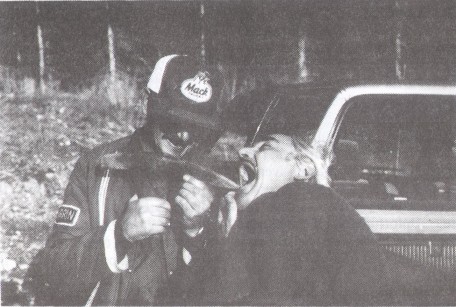
Larrin Wanechek using a "B.C. Toothpick" on his brother,
Wayne.
Primarily due to the inclement weather, we were down to three working metal
detectors, so we doubled up as a "detector" and a "digger".
We scoured the area for the better part of an hour, turned up a number of metal
fragments that indicated the path had been used at least as a mining access
road, but no positive evidence of a telegraph line. Time for a break.
Unfortunately, the break turned out to be Wayne inadvertently stepping on his
metal detector and snapping the bracket that held the coil. Now there were
two.
After a brief rest and a few unprintable words about the detector, we decided
to head back up the mountain for other possible signs of the telegraph lead. Did
I fail to mention that it had been raining/snowing the whole morning? Back
"up and down" the side of the mountain in search of the right trail.
The thing that made finding the right spot so difficult was that apparently
several trails had been cut across the face of the mountain, and as sloughing of
dirt and trees made lower trails impassable, paths were cut higher on the face
of the mountain. Obviously, no records were left to indicate which trail was
active when the telegraph line was installed. Another hour of poking and digging
and we headed back to camp. I was flat exhausted. Everyone was soaked.
Three of us reached camp first and started a fire during a brief break in the
rain. By the time the other two got back, snow had begun in earnest. A decision
had to be made. There were five votes for breaking camp and heading to the
closest big town to dry out and replace/augment some inadequate wet weather
gear. Unbelievably. we hadn't driven more than a quarter of a mile from camp
when the sun broke through. We strongly suspected that we had been right on the
snow line, but we couldn't believe how quickly it cleared as we headed down the
mountain. As Dennis described it, all the lousy weather piled up against the
mountain, and we were right where it piled up.
On the way into town, we stopped at a restaurant for pie and coffee. Next
stop, the laundromat. No time to wash the clothes so we just threw everything
into the driers. That included rain gear, gloves, jackets, sleeping bags (damp
from the constant 100% humidity), etc. The next folks to use those driers
probably won't be happy. An hour in the driers coupled with warm (55 degree)
sunshine outside and we were ready to head out again.
We had to make a decision as to which direction to take. There are a number
of different digging opportunities in B.C., a number of which cover sections of
the Collins Line which was what I was hoping to see. One section had been worked
several times by Larrin, Aidan and Wayne. Dennis and I had never seen it, and
with some reluctance, the group decided to try it one more time.
One more stop at the logger/outfitters shop for rain gear and a file to
sharpen the chain saw. By 5:30 p.m., I was ready for my first look at the famous
Collins Line. I soon learned about another pioneer in the insulator hobby --
Dwight Dodge. He has done a lot single-handedly to try to preserve the old
telegraph trails. We stopped for dinner at a location where I took the following
pictures of one of the signs he has posted. The longer shot shows the impact of
his work.
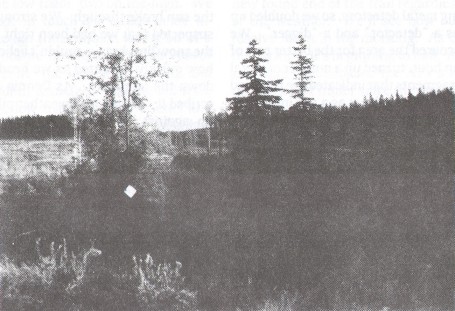
Tree line along the Telegraph Trail
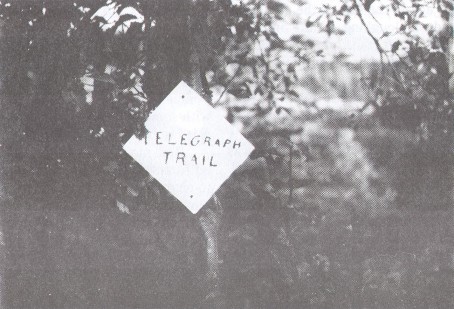
Close-up of one Dwight Dodge's signs which marked and saved the trail.
You can see one thin line of trees where an area was logged in its entirety
except for the trees on the trail that Dwight marked. In case there was any
doubt, one person CAN make a difference in helping to preserve the history of
our great hobby.
About an hour of detecting at this location with no sign of anything except a
few "hot rocks" and we headed deeper into the wilderness. I caught
sight of my first bear in the wild this evening. It was about a quarter of a
mile away in a field. I was glad I was in the truck. At this point, I probably
ought to mention what we are carrying to defend ourselves against the bears. Our
weapons essentially consisted of two aerosol cans -- one was an air horn (I
think Wayne may be responsible for a rash of heart attacks experienced by the
cattle in B.C.) and the other was an innocent looking can called "Counter
Attack". It's supposed to drop a bear in its tracks if you spray it within
20 feet of the bear. Who wants to get within 20 feet of the bear to find out if
it works! Anyway, another hour down the road and we stopped at a campground (we
were the only ones there) with a facility that was a significant step up (you'll
excuse the expression) from our earlier stops. An altogether pleasant afternoon
and evening.
Sept. 9 - As has become our custom, we rose at 6:30 a. m. After
breakfast, we have three more hours on the dirt road to reach our destination.
We pass three bears (at different times) on the road, again all a safe distance
from our vehicles. It was on this portion of the trip that I was introduced to a
new way of looking at road signs. Two in particular that seem to be worth
reporting here are Cattle Guard and Slow Cattle. Wayne kept asking where the guy
was that supposed to be guarding the cattle. After all, the sign said somebody
should be out there protecting those little critters. And then there's the slow
cattle issue. Maybe it's a function of inbreeding. Anyway, it's kind of a sad
situation that the farmers in B.C. have to deal with. And here I thought it
meant you were supposed to slow down to watch out for the cattle. That's what I
like about these trips -- so much to learn.
Late morning, we set up camp near a beautiful lake and prepare our gear to
start working the line. We are working a section of the tree "clear
cut" where both the Yukon and Collins Lines passed, so we have double the
opportunity to find relics. Larrin, Aidan and I head into the woods. Wayne and
Dennis drive back down the dirt road and head into the woods there. The cut line
is only a few hundred yards from the dirt road so we arrive quickly, although it
is all uphill.
I was amazed at how much wire was still standing, that is, lying on the
ground. The poles of both lines have long since disintegrated, but the wire has
withstood the test of time. We were still short on detectors, although the drier
weather and a repair job got us back up to four, so I worked primarily as
assistant digger when the "beep" sounded. In the meantime, I collected
a variety of tie wires (still on the line) and splices from both lines. Although
I am not a wire collector, I thought the chances of me stumbling on an insulator
were remote, and I wanted at least a few souvenirs.
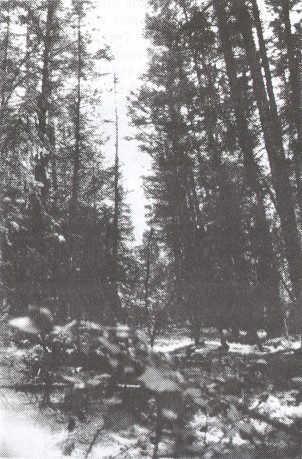
Picture of clear cut line where the telegraph
line passed through the trees.
It was mid afternoon when one of our party let out a war hoop. Larrin had dug
over half of a CD 735 Chester in light aqua. It was top to bottom on the
unembossed side. The glass that was there was beautiful -- nice and bubbly.
Needless to say, the three of us dug the area thoroughly, but no other pieces
turned up. We worked the line most of the rest of the afternoon. Lots of nails
and wire, but no more glass. About 5:00 p.m., we heard the truck with the other
two coming back. Dennis had reeled in enough wire to provide communications for
a small city. They also said they had inadvertently walked through an active
bear's den. Except for the incredible claw marks on the side of the tree, I'll
skip the details on how they identified it. The good news was the bear wasn't
home.
Dennis and I stayed in camp, started the fire and began dinner while the
other three took a preliminary look at the line heading in the other direction
from camp. After dinner, we sat around the campfire, dried boots, told bear and
wolverine stories (I wonder why) and hit the sack promptly at 10:00 p.m.,
Larrin's bedtime.
Sept. 10 - We're getting a little soft! We don't get up this morning
until 6:50 a.m. Larrin scolds us for our late start. He chides us with his now
famous line, "Pitter patter (or was it skitter scatter), let's get at' er!"
The brothers decide that it's a good morning to take a bath in the lake. I'm
guessing the temperature of the water was in the mid-40's. I'm sorry I didn't
get any pictures, but the size of some of the goose bumps would have been
worth submitting to Guinness. At any rate, with a little; hustling, we are ready
to hit the trail shortly after 8:00 a.m. We can walk from our campsite to our
starting point, maybe half a mile. I'm spending most of my time with Wayne.
After a number of stops, we come upon an interesting looking tree where Wayne
gets a few signals on his detector. We do a little scratching without uncovering
anything particularly interesting.
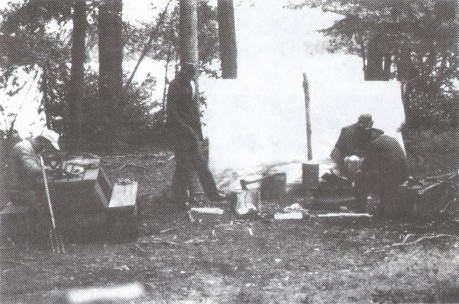
Campground at the lake with Dennis' windbreak
Right next to the first tree is a tree with about an eight inch trunk but a
burl that is nearly three feet in diameter at the base. Wayne gets a few
signals, but about that time, Larrin comes up and, incredibly, Wayne says to
him, "this looks like a pretty good place, Larrin. Why don't you dig
here?" Wayne and I move on, but we haven't even gotten to the next digging
opportunity when Larrin screams, "Glass! Sure enough, we rushed back, and
Larrin was holding nearly all of the top of a CD 735 Chester. We left Larrin to
continue digging for the other parts of the insulator.
One pole up, Wayne gets another signal and digs up three tapered nails --
sure signs of a Collins pole. We do some scratching in the area without success.
Then Wayne starts to do some probing with the long-tined end of his digging
tool. Clink! He digs and comes up with the very top of another Chester. Just
then, we hear another yell from Larrin. He's found two more pieces to his
Chester. It's about 98% complete. We take a few minutes to stop and admire his
find. However, not too long 'cause time's a'wasting on Wayne's find. All five of
us begin digging at the site of the lonesome top. A half hour and the movement
of a ton of moss, din, decayed wood and roots, and nothing, It's unbelievable
that Larrin's find could be all compactly located in one square foot of space,
and we couldn't even find a shard of Wayne's piece in an area surrounding the
original find and radiating out 25 feet in all directions. That represents the
highs and lows of insulator digging, all in one morning and just one pole apart.
The old saying, "a miss is as good as a mile" seems appropriate.
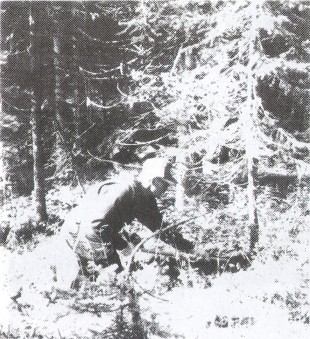
Larrin closing in on a valuable relic.
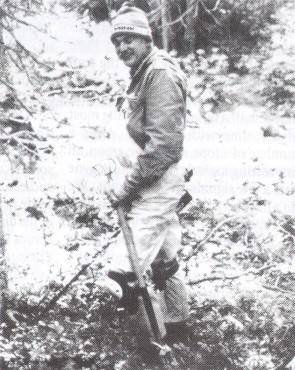
Wayne in his digging uniform.
It's lunch time. Aidan and I cut across country back to the campsite, prepare
lunch and return while the others continue to dig. After lunch, we resume.
Dennis, who has sort of assumed the role of scout, has gone ahead to mark the
trail, note highlights and report back periodically. While there are plenty of
indicators, there is little to excite the avid digger early this afternoon.
Wayne and Aidan each find an unembossed Gisborne white porcelain beehive from
the Yukon line. Wayne's is broken, and I dig up a few fragments -- my first
unearthing' of an insulator. Aidan generously offers me his mint Gisborne which
I gladly accept. It's not from the old line, but it's approaching 100 years, and
after a week of digging, I'm beginning to get an appreciation both for the
history of these lines and the dedication it takes to be a "digger".
Thanks, Aidan.

Dennis ''blazing the trail"
Later that afternoon, Aidan makes his find -- a light aqua CD 735 Chester.
With some help, he finds four pieces which leaves only about one-third of the
skirt missing. We search in vain for the balance. In the process, we have
created a lot of work for one squirrel or chipmunk in order to get his winter
store back in shape.
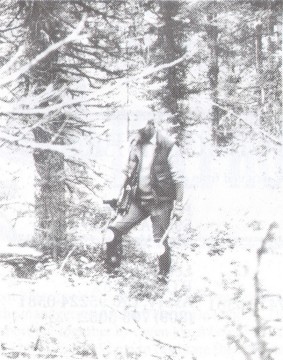
Aidan unearthing the Gisborne
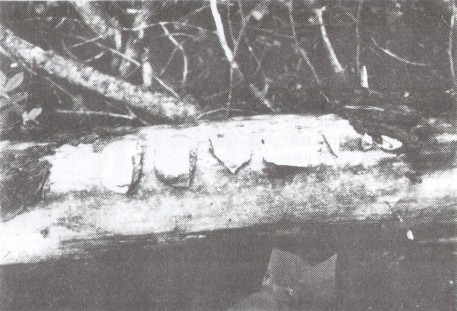
John's first "unearthings" - pieces of Gisbornes
We dig for another hour or so and decide we need to get back to break camp in
daylight and head for civilization. By 6:00 p.m. we are on the road. Four and a
half hours later, we pull off at a rest stop for the night. Lights out at 11 :30
p.m.
(Final episode....next issue)
| 